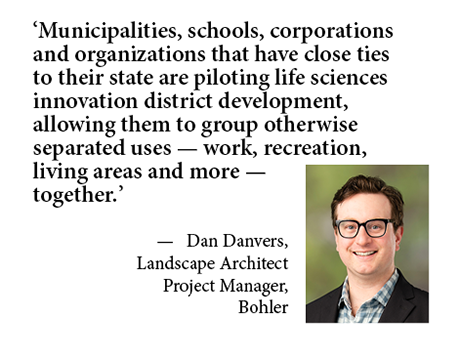In the biotech and pharmaceutical sectors, life sciences innovation districts have become hubs not only for research and development but also for cooperation and inspiration between cohorts. These districts, often called innovation districts, collect together companies, research institutions, supporting entities, housing and more. Innovation districts necessitate meticulous planning and design strategies to promote scientific inquiry and efficiency.
“Municipalities, schools, corporations and organizations that have close ties to their state are piloting life sciences innovation district development, allowing them to group otherwise separated uses — work, recreation, living areas and more — together. When you pair these institutions and include innovative site and building programming in a single location, you move beyond disconnected projects and amenities to a united innovation district that can magnify benefits across organizations,” explains Dan Danvers, a landscape architect project manager with Bohler, a land development consulting and site design company.
This article is the design-focused component of our two-part series on life sciences innovation districts. If you would like to read about the planning component of these complex developments, please read our first article here.
Moving Life Sciences Innovation Districts Forward

Innovation districts must keep pace with evolving technologies and research. Life sciences industries are continually progressing, and innovation districts must adapt and incorporate new technologies and ideas to remain relevant and competitive. “Designing for phased progress in these districts can mean having permits and utility plans well in advance to speed the overall development process up,” says Charlie Yowell, a Raleigh-based principal for Bohler. “It’s important to have local experts familiar with your long-term plan to help slot these time-saving strategies and designs into a project, to avoid the need for costly changes later.”
Fostering collaboration and productivity in life sciences innovation districts requires attention to design to streamline development processes and inspire each building’s residents. “Life sciences companies often require specialized facilities that can be costly to build. To encourage innovation and flexibility, each building within the district must be designed to allow for modifications and upgrades as needs change,” says Yowell.
Navigability and Safety
Parking lots, roads and delivery bays can all benefit from in-depth design, especially from a grading and earth-moving perspective. “On a macro scale, you’re considering long-term streamlining for things like delivery or distribution trucks and how much time might be lost in slowing down due to approaches or cross traffic with employees,” Danvers highlights. “These inefficiencies will add up incrementally over the life of the building. Understanding and reflecting the desired operations, preferred employee metrics and the values of each individual company makes for better-designed routes.”
Clear wayfinding — the practice of using design elements like signs, colors and elevation to improve tenant navigation — represents a vital safety component for an industry where laboratories and other light-sensitive workspaces often require secure, clean environments without windows to protect samples, projects and data. Life safety and security systems must fit seamlessly into a building’s functions, while paths for egress remain obvious. Measures such as controlled access, security cameras and emergency response plans should also be considered and integrated within the larger design.
Fostering Long-Term Connection Via Design
Design plays a crucial role in promoting long-term connections and community in life sciences facilities. Shared workspaces and well planned indoor and outdoor amenities promote knowledge transfers between employees and a sense of belonging.
Creating a welcoming environment is key to meeting the needs of the people in these spaces. Live-work-play environments, with housing, retail and restaurants, are incorporated into many of these developments to address tenant expectations. Fitness centers, hiking trails and outdoor amenities promote health and well-being.
Planning grading and design early on can help meet accessibility requirements and minimize costs. It also ensures people can navigate the site easily and enhances visibility and the sense of arrival for guests and employees.
Challenges and Future Considerations
While life sciences innovation districts have the potential to bring economic growth and scientific advancement to communities, there are also several challenges and considerations that design can help address.
Balancing economic growth with community needs helps ensure that innovation districts continue to sustainably serve tenants and residents. Innovation districts have the potential to attract high-paying jobs and significant investment, but they can also drive up housing costs and contribute to unsustainable gentrification. It is crucial to ensure that innovation districts are developed in a way that benefits the community and that affordable housing, comprehensive transport and other community needs are taken into account. Convenient, affordable transportation options and ample parking accommodate the needs of tenants and visitors and help welcome the surrounding community. Designing for walkability also unites the campuses.
Comprehensive planning and design strategies are crucial in building successful life sciences innovation districts. These districts offer significant economic and scientific potential, but their success depends on careful consideration of site selection, zoning regulations, infrastructure development, public engagement and sustainability. Additionally, design strategies such as flexible building designs, collaborative workspaces, accessible transportation, green space integration and security measures can enhance the success of these districts.
The future of life sciences innovation is bright, but it is essential to ensure that these districts are designed and developed in a way that enhances usability, regardless of socioeconomic status, need for accommodations or background. By addressing challenges and considering future needs, life sciences innovation districts can promote scientific advancement and economic growth while also prioritizing the needs of the community.
Bohler is a content partner of REBusinessOnline. For more articles from and news about Bohler, click here.
Read Part 1 of this series on life sciences innovations here.


